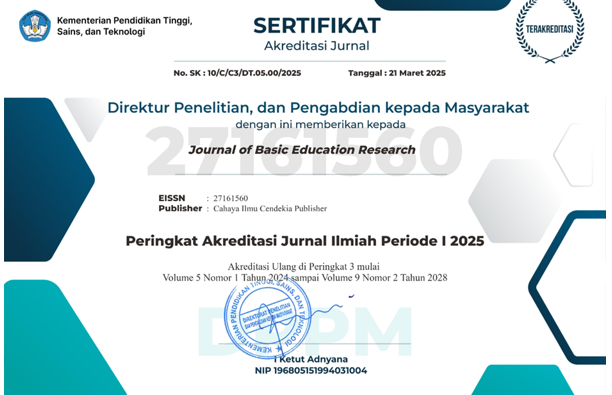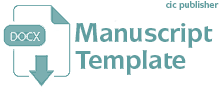The Use of Fractional Card Media-Based Concept Attainment Models to Improve Understanding of Fractional Concepts
Abstract
Purpose of the study: To find out the application of the Concept Attainment model with the help of fractional card media in increasing understanding of the concept of fractions in class II Ahmad Dahlan Elementary School.
Methodology: The research was conducted at Ahmad Dahlan Elementary School in the even semester of 2018/2019. The research sample was 22 students. Research data obtained through student learning outcomes and observation sheets. Quantitative data were analyzed using descriptive statistics and Qualitative data were analyzed to determine the learning process using the Concept Attainment learning model based on fractional card media.
Main Findings: The results of the study show that the application of the Concept Attainment model assisted by fractional card media can improve understanding of the concept of fractions. By observing the results of understanding the concept of fractions in the first cycle, namely 53.01%, it increased in cycle II to 77.12%. In cycle I the results of the written test evaluation with classical completeness of 63.15% increased in cycle II by 18.66% to 81.81%.
Novelty/Originality of this study: The latest research in this research is to combine the concept learning learning model with fraction card media which is generally not widely used, especially for learning fractions in elementary school mathematics, the benefits for students in this action research will then make it easier for them to face more difficult learning levels in the next class and can become a new teaching idea for teachers to facilitate student understanding.
References
M. R. Maulani, S. Supriady., and N. Riza, “E-Learning implementation to increase student participation in learning to make it more interactive and fun”, Scientific Journal of Applied Information Technology, vol. 7, no. 1, pp. 27–35, 2020. https://doi.org/10.33197/jitter.vol7.iss1.2020.489
B. Sitepu, “Application of 2013 curriculum-based elementary school christian religious education materials and their influence on student achievement”, Tabernacle Theological Journal of David, vol. 6, no. 1, pp. 71–78, 2020.
N. Tambunan, “Obstacles to implementing islamic religious education at lobugoti state elementary school, pangaribuan district, north tapanuli regency”, Scientific Journal of Al-Hadi, vol. 2, no. 2, pp. 477–484, 2017.
K. Kamid., J. Marzal., N. N. Simamora., A. Ramadhanti., and M. Iqbal, “Study of ethno-mathematics and vygotsky's constructivism on jambi traditional marriages”, Educational Sciences: Theory & Practice, vol. 21, no. 4, pp. 123-137, 2021.
R. Reski., N. Hutapea., and S. Saragih, “The role of problem based learning (PBL) models on the ability of mathematical problem solving and student learning independence”, JURING (Journal for Research in Mathematics Learning), vol. 2, no. 1, pp. 049-057, 2019.
D. Destiniar., J. Jumroh., and D. M. Sari, “Ability to understand mathematical concepts in terms of student self-efficacy and the Think Pair Share (TPS) learning model at SMP Negeri 20 Palembang”, JPPM (Journal of Research and Learning Mathematics), vol. 12, no. 1, pp. 115-128, 2019.
N. Maslahah, “Active, creative, effective and fun learning model (PAKEM) with interactive media: impact on understanding mathematical concepts”, SYSOLOGISM JOURNAL: A Study of Mathematics and Its Learning, vol. 7, no. 1, pp. 29-37, 2022.
M. Makrif., S. Istiningsih., and A. N. K. Rosyidah, “The effectiveness of the missouri mathematics project learning model (pmm) on the mathematical creativity ability of fifth grade students at SDN 1 Bagik Polak Academic Year 2021/2022”, Educational Professional Scientific Journal, vol. 7, no. 3, pp. 1186-1196, 2022.
P. Gunowibowo., and A. P. Wijaya, “The effect of the guided discovery model on understanding mathematical concepts”, Unila Mathematics Education Journal, vol. 7, no, 2, 2019.
T. Rahman, “Study of the theory of the effect of the knisley learning model on increasing students' ability to understand mathematical concepts”, Symmetry: Pasundan Journal of Research in Mathematics Learning and Education, vol. 5, no. 2, pp. 197-213, 2022.
T. Kusmayanti, “The effect of emotional intelligence and independent learning on understanding of mathematical concepts (survey at public middle schools in cilegon city)”, ALFARISI: Journal of MIPA Education, vol. 1, no. 3, 2022.
P. W. Koh., T. Nguyen., Y. S. Tang., S. Mussmann., E. Pierson., B. Kim., and P. Liang, “Concept Bottleneck Models”, In International Conference on Machine Learning (pp. 5338-5348). PMLR, 2020.
N. A. Yensy, “Understanding student concepts through the concept attainment learning model”, Raflesia Mathematics Education Journal, vol. 5, no. 1, pp. 64-74, 2020.
R. Febriana, “Teacher competence”, Bandung: The Literary Earth, 2021.
N. H. Harahap, “Efforts to improve student learning outcomes by using the cooperative learning model of the index card match (ICM) type in the mathematics subject of fraction material in class V SD Negeri 205008 Sihitang” (Doctoral dissertation, IAIN Padangsidimpuan), 2021.
E. Sumarwanti, “The use of plots of fraction sequence plots to increase students' competence in determining a particular order from a group of random fraction numbers”, Action Research Journal, vol. 1, no. 1, pp. 30-39, 2021.
M. A. Sidiqin, and S. Siregar, “The effect of audio visual media on the ability to write exposition texts of class x students of smk satria nusantara binjai for the 2019/2020 Academic Year”, Indonesian Journal of Trumpets, vol. 17, no. 1, pp. 35-41, 2020.
F. A. Zahwa., and I. Syafi'i, “Selection of information technology-based learning media development”, Equilibrium: Journal of Education and Economic Research, vol. 19, no. 1, pp. 61-78, 2022.
Nugraheni, et al. “The use of fractional card media to improve mathematics learning outcomes of fractional concepts”, Thesis: PGSD FKIP Sebelas Maret University Surakarta, 2010.
A. F. Ritonga, “Evaluation of student learning outcomes on fractional material in class IV SD Negeri 200410 Hutaimbaru Padangsidimpuan City” (Doctoral dissertation, IAIN Padangsidimpuan), 2021.
N.Kotib, “Efforts to Improve Mathematics Learning Outcomes in Learning Simple Fractions through the Media of Fraction Cards for Grade VI Students of SDN Temon, Trowulan District, Mojokerto Regency, 2018/2019 Academic Year”, PROGRESSA: Journal of Islamic Religious Instruction, vol. 4, no. 1, pp. 51-68, 2020.
M. Fitrah, “The use of valuable fractions domino card media in stem approach-based mathematics learning”, Axiom, vol. 9, no. 1, pp. 51-56, 2020.
E. Harlina, “Improving Mathematics Learning Outcomes and Implementation of Type Make A Match by Utilizing Number Cards”, Southeast Sulawesi Educational Journal, vol. 2, no. 2, pp. 107-117, 2022.
I. Safitri., H. S. Bintoro, S. Wanabuliandari., and M. Kudus, “Analysis of mathematical problem solving ability in view of student learning activities in the RME model assisted by cool cards in Grade V students”, Journal of Prakarsa Paedagogia, vol. 4, no. 1, 2021.
K. Kiptiyah, “Improving mathematics learning outcomes comparing and sorting decimal fractions, through the playing method using fractional card media, for Grade VI Students at SDN Klantingsari 2 Tarik Sidoarjo”, Journal of Education Learning and Research (JPRP), vol. 2, no. 2, pp. 31-36, 2022.
H. Fitriani., R. Imanda., A. Rahmi., and S. Nurmalinda, “The development of flashcard learning media based on make a match on colloid”, International Journal for Educational and Vocational Studies, vol. 3, no. 5, pp. 373-379, 2021.
D. Putri, “Concept attainment learning models in improving understanding of mathematical concepts”, Journal of Educational Thought and Research, vol. 15, no. 1, 2017.
A. Astalini., D. Darmaji., D. A. Kurniawan., and N. N. Simamora, “Comparison of perception and implementation of mathematical physics for matrices”, Journal of Physics and Scientific Education (JPFK), vol. 7, no. 1, pp. 53-72, 2021.
A. Ramadhanti., K. Kholilah., R. Fitriani., E. F. S. Rini., and M. R. Pratiwi, “Relationship of motivation to class x mipa physics learning outcomes at SMAN 1 Jambi City”, Journal Evaluation in Education (JEE), vol. 3, no. 2, pp. 60-65, 2022.
N. N. Simamora., A. Astalini., and D. Darmaji, “Analysis of student needs for mathematical physics e-module”, MIPA EDUCATION JOURNAL, vol. 12, no. 1, pp. 1-7, 2022.
A. Astalini., D. Darmaji., D. A. Kurniawan., and A. Ramadhanti, “Mathematical physics e-module: study of students' perception based on gender”, Journal of Education Technology, vol. 6, no. 1, 2022.
L. Suryani, “Efforts to improve manners talking with peers through group guidance”, Education Partners E-Journal, vol. 1, no. 1, pp. 112-124, 2017.
A. Ramadhanti., A. Astalini., and D. Darmaji, “Analysis of student needs for the use of e-modules in mathematics physics i lectures vector material”, Mipa Education Journal, vol. 12, no. 1, pp. 13-19, 2022.
L. Angraini, “The influence of concept achievement learning models on students' understanding of mathematical concepts”, Thesis: Department of Mathematics Education, Faculty of Tarbiyah and Teacher Training, UIN Syarif Hidayatullah Jakarta, 2010.
W. Istuningsih, “The effectiveness of concept attainment and mind mapping learning models on student learning outcomes in economics subjects class xi ips sma negeri 2 karanganyar academic year 2015/2016”, Thesis: FKIP, UNS Surakarta, 2015.
Copyright (c) 2023 Auliya Ramadhanti, Nadia Natalia Simamora

This work is licensed under a Creative Commons Attribution-NonCommercial 4.0 International License.
Authors who publish with this journal agree to the following terms:
- Authors retain copyright and acknowledge that the Journal of Basic Education Research is the first publisher licensed under a Creative Commons Attribution 4.0 International License.
- Authors are able to enter into separate, additional contractual arrangements for the non-exclusive distribution of the journal's published version of the work (e.g., post it to an institutional repository or publish it in a book), with an acknowledgment of its initial publication in this journal.
- Authors are permitted and encouraged to post their work online (e.g., in institutional repositories or on their website) prior to and during the submission process, as it can lead to productive exchanges and earlier and greater citation of published work.





.png)


.png)
.png)


















